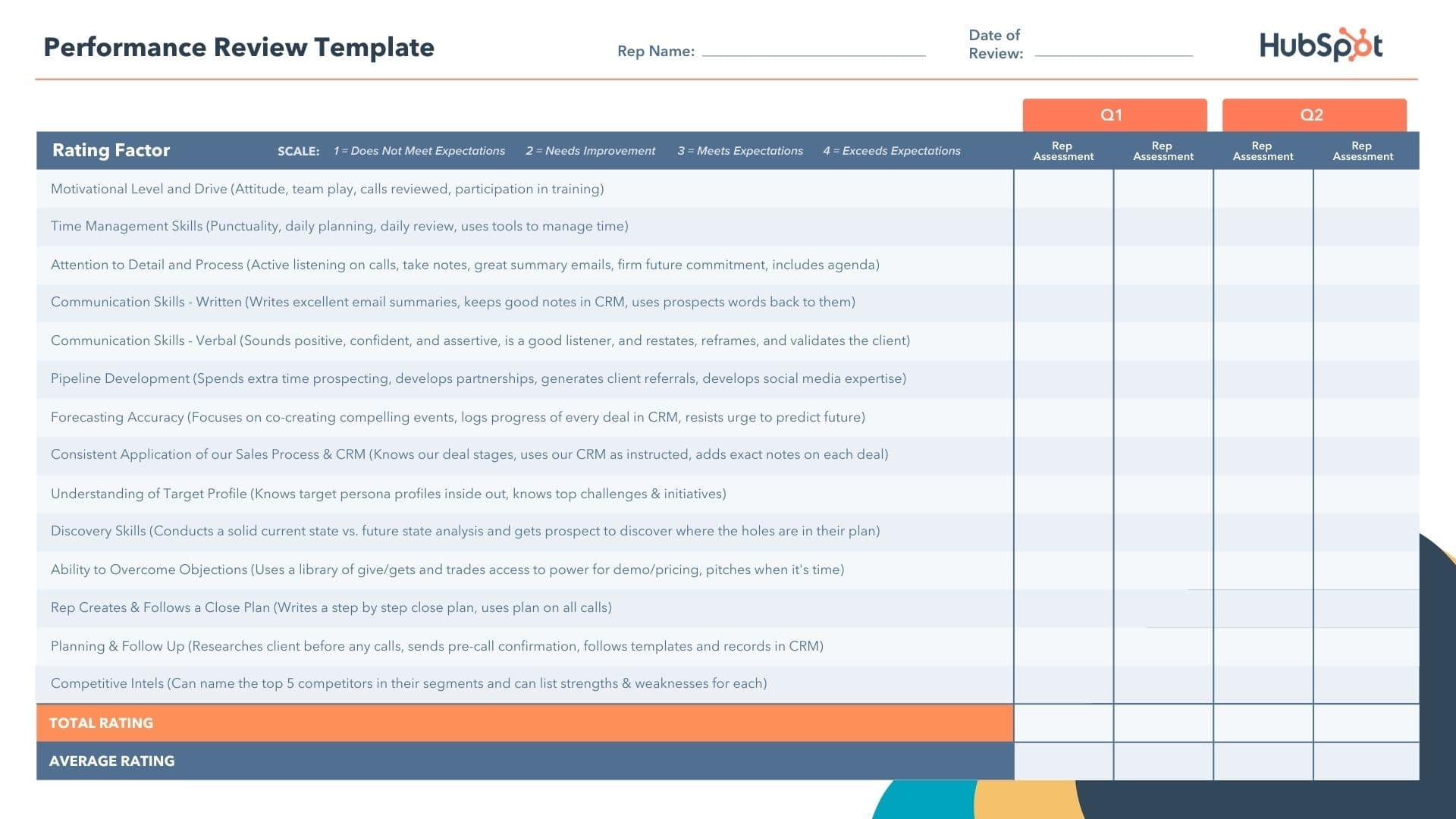As a manager, your ability to inform your teams about the successful high-impact behaviors they exhibit or skills that need further development is a critical practice in determining your business’ overall ability to reach its goals and find success.
In this post, learn how a performance appraisal will help you give employees direction, the different types of performance appraisals, and example comments to include when you schedule those 1:1 sessions.
Businesses use performance appraisals to understand employee progress, give raises or promotions, create paths for further development, or, sometimes, discuss terminations.
These appraisals typically happen multiple times per year at different intervals, like quarterly, annually, or specific periods that make sense to your business. The goal, however, is for managers to conduct them regularly enough that employees always understand how they are doing.
Performance Appraisal Methods
There are different ways to conduct performance appraisals that can depend on your business’s individual needs, or on a manager-to-manager basis, depending on what you think is a best practice. Below we’ll go over the most popular types of performance appraisal methods.
1. Management by Objectives
Management by Objectives (MBO) is a popular sales management style that is also used for performance appraisals.
With this strategy, the manager and employee work together to set goals the employee will strive to meet during a specific period. During the performance appraisal session, they will review how the employee has or has not met the goals, and set new goals that will be evaluated during the next appraisal period.
2. 360-Degree Feedback
The 360-Degree Feedback method uses feedback from an employee’s self-evaluation, manager evaluation, peers, and if applicable, direct reports and customers.
This method is valuable as it provides employees with a big picture view of their performance across multiple perspectives and areas of business, rather than just a manager’s perspective. It also gives employees an understanding of how their actions affect various people at their place of work, not just how their job progress does or does not help the company meet its goals.
3. Self-Evaluation
The self-evaluation performance appraisal is when employees rate their performance based on a set list of criteria provided by management. When employees assess their own performance, they take a critical look at their progress to truly understand their efforts.
It’s important to note that, when using this method, employees may struggle to analyze their performance from an outside perspective and rate themselves too high or too low. Therefore, managers may find that this process is best supplemented by manager feedback, where you respond to employee evaluations with your insights into their performance.
4. Behavior Checklist
Using a behavior checklist for performance appraisals is when a manager has a list of traits required for the position (i.e., works well with others) and checks off those that an employee embodies and leaves blank the ones that need improvement.
This method is relatively straightforward as the checklist explicitly states desired behaviors, so those that aren’t checked off can be used to spark valuable conversation about further skill development.
5. Rating Scale
The Rating Scale performance appraisal uses a set of skills expected for a specific job that a manager uses to evaluate an employee, usually on a scale of 1-4 from meeting expectations to exceeding expectations.
At the end of the scale, the employee receives a total score calculated from each of the ratings.
Performance Appraisal Comments
Regardless of the appraisal method used, it’s essential to give feedback that is helpful to the employee and teaches them about their performance. Below we’ll go over some examples of comments that can be made during a performance appraisal session, whether written or spoken.
Organization Performance Appraisal Comment
Positive Comments
- "You're incredibly organized, which allows you to be efficient and timely in completing your tasks."
Needs Improvement Comments
- “You might benefit from spending more time organizing and planning for your tasks before you begin working on them.”
Time Management Performance Appraisal Comment
Positive Comments
- “You always meet deadlines and prioritize your work in an organized manager.”
Needs Improvement Comments
- “I’d like to see you pay careful attention to deadlines and develop a time management system that helps you meet due dates.”
Leadership Performance Appraisal Comments
| positive comments | needs improvement comments | |
| For someone with direct reports | “You effectively manage your teams and are a fair and encouraging leader. Members of your team consistently refer to you as a role model.” | “I’d like to see you spend more time working with employees that face roadblocks rather than encouraging them to find every solution on their own.” |
| For someone without direct reports | “You’re always able to step up to the plate and take charge when the opportunity arises, and you work to be supportive of your teammates.” | “I’d like to see you take the lead on projects that arise that are related to your expertise and skillset.” |
Critical Thinking and Problem Solving Performance Appraisal Comments
Positive Comments
- “You’re always able to think critically and review all of the facts of a situation before making decisions.”
Needs Improvement Comments
- “Sometimes you act too quickly when problems arise, so I think you can benefit from spending more time analyzing a problem before jumping into a solution.”
Productivity Performance Appraisal Comments
Positive Comments
- “You’re detail-oriented, which allows you to be productive at work and effectively organize and complete tasks on time.”
Needs Improvement Comments
- “I’d like to see you be more productive at work, so improving your organization and time management skills may be helpful.”
Teamwork Performance Appraisal Comments
Positive Comments
- “You work well with others and are supportive of your team members’ needs. You’re always ready to help when asked and respectful of others and their positions.”
Needs Improvement Comments
- “I’d like to see you devote more time to collaborating with your teammates and being more open to working with them and learning from their experiences.”
Communication Performance Appraisal Comments
Positive Comments
- “You’re able to effectively communicate all the time, regardless of the situation. I consistently hear from others that they always understand what you’re saying.”
Needs Improvement Comments
- “I would like to see you practice active listening with your peers and communicating when you feel as though you need help.”
Creativity Performance Appraisal Comments
Positive Comments
- “You always find unique and creative approaches to your work duties and find solutions to issues that arise.”
Needs Improvement Comments
- “You tend to focus on traditional processes for solving problems, and I would like to see you branch out and find creative solutions to issues that may come up.”
Performance Appraisal Example
The image below is an example of a performance appraisal using a rating scale. In the template, there is a list of behaviors that the employee is expected to have and use at work, like attention to detail and communication skills.
The manager or person providing feedback rates the employee on a scale of 1 to 4 based on how they express the skill, from Does Not Meet Expectations to Exceeds Expectations. The employee then receives a total numerical rating that you can use to drive discussions about further development.
When it comes down to your business’s bottom line, employees are direct contributors. Use performance appraisals to help your employees understand their job performance, so they know exactly which behaviors to continue practicing and which areas of opportunity to seek out additional development.



